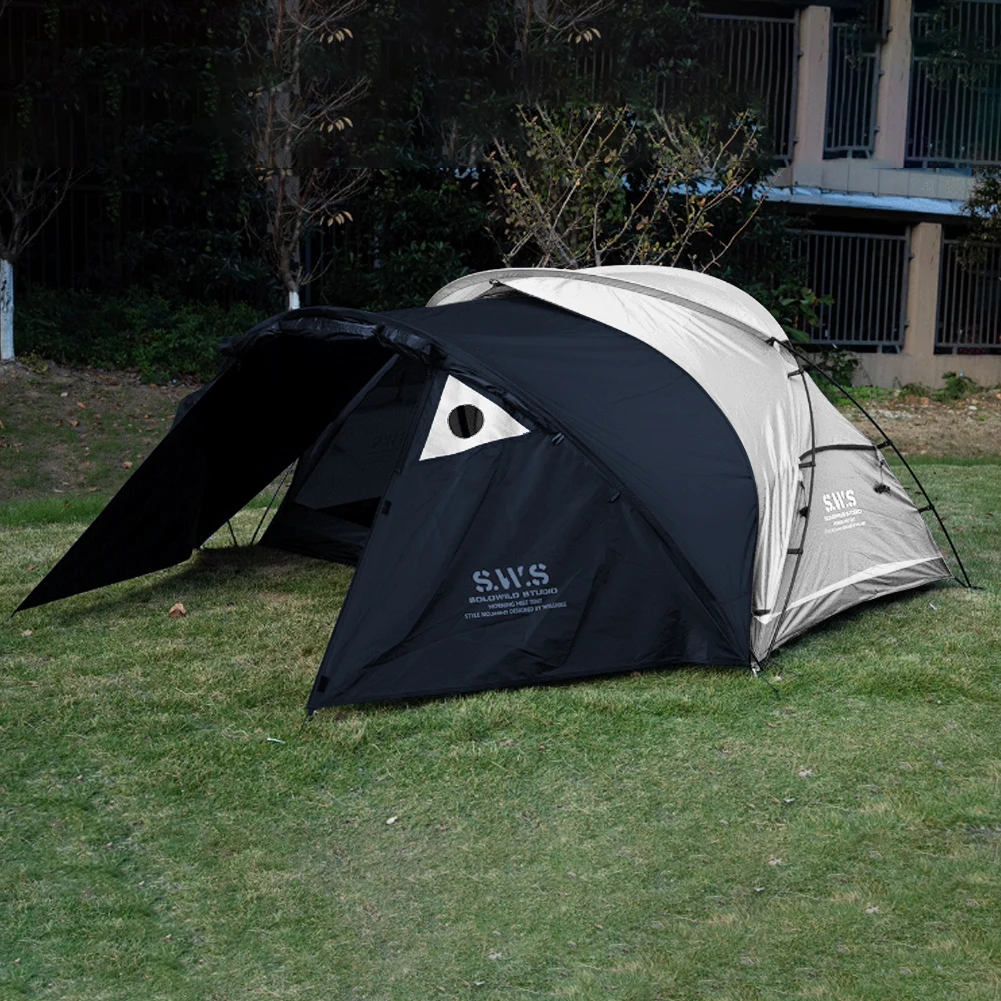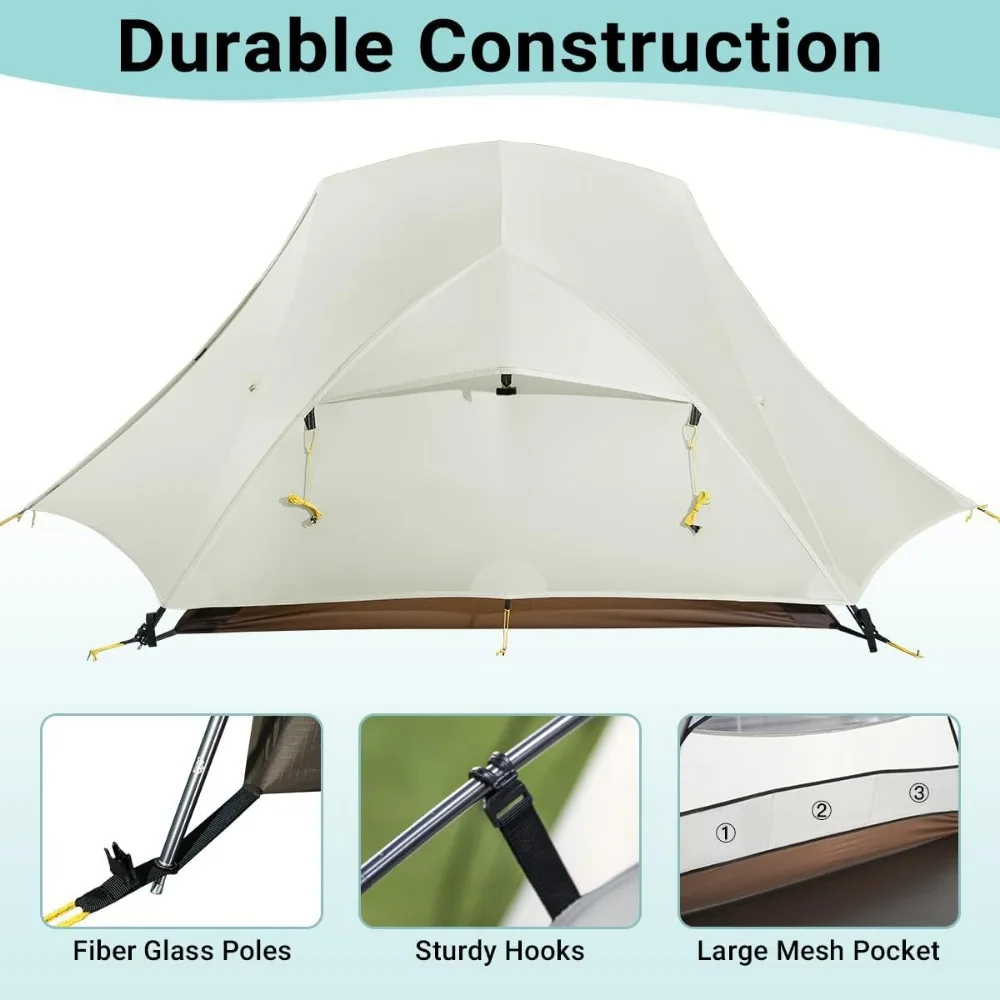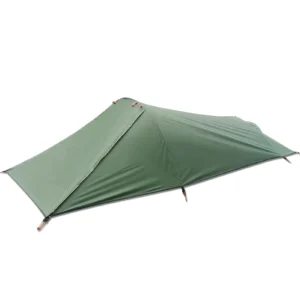Understanding Backpacking Tent Weight: Is 3kg Heavy?
When you’re planning a backpacking trip, every ounce in your pack matters. So, is a 3kg (6.6 lbs) tent too heavy for backpacking? The short answer is: for most backpackers, yes—a 3kg tent falls into the heavier category by modern standards.
However, whether it’s “too heavy” for you specifically depends on several important factors:
- Your physical condition and hiking experience
- The length and difficulty of your planned trips
- Whether you’re sharing the tent weight with a partner
- Your personal comfort preferences and priorities
- Your budget constraints
Tent weight is particularly important because your shelter is one of the big three heaviest items in your backpack, alongside your sleeping system and backpack itself. These three items often account for the majority of your base weight (everything except consumables like food and water).
Modern lightweight tents for long treks have dramatically reduced in weight over the past decade, creating new expectations for backpackers. What was once considered standard weight is now often classified as heavy.
Understanding tent weight categories helps put that 3kg tent in perspective and determines whether it’s the right choice for your specific backpacking needs. Many experienced backpackers find that reducing pack weight significantly enhances their hiking enjoyment and reduces physical strain, especially on longer journeys.
If you’re already browsing options, our selection of lightweight backpacking tents might give you a better sense of what’s available in different weight categories.
Backpacking Tent Weight Categories: What’s Light vs. Heavy?
Understanding tent weight categories helps you gauge where that 3kg tent falls on the spectrum. Here’s how modern backpacking tents typically break down by weight:
| Tent Category | 1-Person | 2-Person | 3-Person |
|---|---|---|---|
| Ultralight | <1 kg (2.2 lbs) | <1.4 kg (3 lbs) | <1.8 kg (4 lbs) |
| Lightweight | 1-1.5 kg (2.2-3.3 lbs) | 1.4-2 kg (3-4.4 lbs) | 1.8-2.5 kg (4-5.5 lbs) |
| Standard/Midweight | 1.5-2 kg (3.3-4.4 lbs) | 2-2.7 kg (4.4-6 lbs) | 2.5-3.2 kg (5.5-7 lbs) |
| Heavy | >2 kg (>4.4 lbs) | >2.7 kg (>6 lbs) | >3.2 kg (>7 lbs) |
Based on this classification, a 3kg (6.6 lbs) tent would be considered:
* Heavy for a 1-person tent
* Heavy for a 2-person tent
* Standard/Midweight for a 3-person tent
It’s worth noting that professional thru-hikers and serious backpackers typically aim for the ultralight or lightweight categories, with many targeting a shelter weight of less than 1kg (2.2 lbs) for solo hiking.
The weight landscape has changed dramatically over the past decade. What was considered a standard tent weight just ten years ago might now fall into the heavy category as materials and designs have evolved.
When sharing a tent, the weight-per-person calculation becomes important. A 3kg tent shared between two hikers means each person carries only 1.5kg (3.3 lbs), which suddenly falls into the standard or even lightweight range on a per-person basis.
Understanding appropriate weights for ultralight tents and learning how much a backpacking tent should weigh can help you make more informed decisions about your gear.
The Real Impact of Carrying a 3kg Tent
The difference between carrying a 3kg tent versus a 1.5kg ultralight alternative might not seem substantial on paper, but on the trail, those extra 1.5kg (3.3 lbs) can significantly impact your hiking experience:
- Increased fatigue: Extra weight requires more energy with every step, particularly noticeable on uphill sections
- Reduced daily mileage: Heavier loads typically slow your pace and may reduce how far you can comfortably travel each day
- Greater strain on joints: Knees, ankles, and hips bear additional stress with heavier loads
- More frequent rest breaks: You might need to stop more often to recover
- Decreased enjoyment: Physical discomfort can detract from the overall experience
Backpackers commonly follow the 20 percent rule, which suggests your pack shouldn’t exceed 20% of your body weight for comfortable hiking. For a 150-pound (68kg) person, that means keeping the total pack weight under 30 pounds (13.6kg).
Let’s see how a 3kg tent impacts this calculation:
For a typical 3-day summer trip:
* 3kg tent = 22% of a recommended 13.6kg pack weight
* 1.5kg tent = 11% of that same weight limit
This demonstrates how a heavy tent consumes a disproportionate amount of your weight budget, leaving less capacity for food, water, clothing, and other essentials.
The impact becomes even more pronounced in mountainous terrain, where each uphill step requires lifting that extra weight against gravity. Over a typical backpacking day covering 10-15 miles (16-24km), the cumulative effect of thousands of steps with extra weight becomes substantial.

For those looking to reduce tent weight, exploring ultralight backpacking tent options can make a significant difference in overall pack weight and hiking comfort.
What Makes a Tent Heavy? Understanding Tent Weight Factors
To evaluate whether a 3kg tent makes sense for your needs, it’s helpful to understand what contributes to tent weight in the first place. Several key factors determine how much a tent weighs:
Tent Capacity
Each person added to a tent’s capacity increases weight. However, the weight-per-person actually decreases with larger tents, as the additional materials needed for extra floor space weigh less than a complete separate tent.
Seasonality
- 3-season tents (spring, summer, fall): Typically lighter with more mesh for ventilation
- 4-season tents: Substantially heavier due to stronger poles, more robust fabrics, and less mesh to withstand winter conditions
Materials
- Fabrics: Denier (thickness) significantly impacts weight—a 70D floor is much heavier than a 15D floor but offers more durability
- Poles: Aluminum poles add weight compared to carbon fiber but cost less and are more durable
- Rainfly coverage: Full-coverage rainflies add weight but provide better protection
Construction Design
- Freestanding tents (can stand without stakes) typically weigh more than non-freestanding options
- Double-wall designs (separate inner tent and rainfly) weigh more than single-wall tents
- Trekking pole tents save significant weight by using your existing hiking poles instead of dedicated tent poles
Comfort Features
- Additional doors and vestibules add weight
- Interior storage pockets and gear lofts contribute ounces
- Vertical walls improve livability but require stronger/heavier pole structures
Understanding lightweight trekking shelter materials can help you make informed choices about which weight-saving features matter most. For significant weight savings, many backpackers choose trekking pole backpacking tents that eliminate the need for separate tent poles altogether.
The Critical Trade-Offs: Weight vs. Other Tent Considerations
When evaluating tent weight, it’s essential to understand that going lighter almost always involves trade-offs. Here’s what you’re balancing when choosing between heavier and lighter tents:
Weight vs. Cost
Ultralight tents typically cost significantly more than standard-weight counterparts. The price difference can be substantial:
* A standard 2-person tent might cost $150-250
* An ultralight version with similar space might run $350-600+
This cost increase comes from specialized materials and more complex manufacturing processes. The price-per-ounce saved increases dramatically at the ultralight end of the spectrum.
Weight vs. Durability
Lighter tents use thinner fabrics with lower denier ratings. While a heavy tent might use 70D floor material, an ultralight might use 15D—making it more susceptible to tears and punctures. After multiple seasons of use, ultralight tents typically show wear sooner and may need replacement earlier.
Weight vs. Weather Protection
Heavier tents often provide more robust weather protection with features like:
* Stronger pole structures that withstand wind better
* Fuller rainfly coverage preventing splash-up and driving rain
* More substantial vestibules for gear storage in bad weather
Weight vs. Interior Space
Lighter tents frequently sacrifice interior volume with:
* Lower ceiling heights
* Less floor area
* Tapered designs that limit usable space
* Steeper wall angles that reduce headroom
Weight vs. Setup Convenience
Many ultralight shelters trade convenience for weight savings:
* Non-freestanding designs require more careful site selection
* Trekking pole shelters add setup complexity
* Fewer poles can mean less stability during setup
For some backpackers, a 2kg tent represents the sweet spot between weight and these other considerations. The right balance depends entirely on your personal priorities and the conditions you typically encounter.
When a 3kg Tent Makes Sense: Scenarios to Consider
Despite the general preference for lighter gear, there are several scenarios where a 3kg tent might be a reasonable or even preferable choice:
Shared carrying between partners: When split between two hikers, each person carries only 1.5kg (3.3 lbs), placing it within a reasonable weight range per person.
Short-distance backpacking trips: For weekend trips covering moderate distances (5-8 miles/day or 8-13km/day), the weight penalty is less significant.
Base camp adventures: If you’re hiking in once and setting up camp for several days of day-hiking, the one-time weight burden may be worth the added comfort and durability.
Winter camping and harsh conditions: In extreme conditions, the added stability and weather protection of a heavier tent can be essential for safety and comfort.
Budget constraints: If you’re just getting started with backpacking, a more affordable heavy tent might be better than no tent at all or straining your budget for an ultralight option.
Durability priorities: If you’re hard on gear or frequently camp in rough conditions, the added durability of heavier materials might prevent premature replacement.
Family backpacking: When introducing children to backpacking, adults might carry heavier gear to ensure a comfortable, positive experience for kids.
When extra durability and weather protection are top priorities, heavy-duty 4-season tents can be worth their additional weight, particularly in alpine or winter conditions.
Lightweight Backpacking Tent, Ultralight Backpacking Tent, Ultralight Bivy Tent
Ultralight Single Person Camping Tent with Aluminum Poles for 3-Season Backpacking Waterproof DesignPrice range: $94.88 through $326.82 Select options This product has multiple variants. The options may be chosen on the product pageLightweight Backpacking Tent, Ultralight Backpacking Tent, Waterproof Backpacking Tent
$391.05 Select options This product has multiple variants. The options may be chosen on the product pageHeavy Duty 4 Season Tent, Mountaineering Tent, Winter Camping Tent
$870.40 Select options This product has multiple variants. The options may be chosen on the product pageCompact Backpacking Tent, Lightweight Backpacking Tent, Waterproof Camping Tent
$335.52 Select options This product has multiple variants. The options may be chosen on the product pageUltralight Backpacking Tent, Ultralight Dome Tent, Winter Camping Tent
Price range: $369.63 through $370.07 Select options This product has multiple variants. The options may be chosen on the product pageHeavy Duty 4 Season Tent, Ultralight Freestanding Tent, Winter Camping Tent
$3,722.66 Select options This product has multiple variants. The options may be chosen on the product page
Finding Your Ideal Tent Weight: Personalizing Your Decision
Determining your ideal tent weight requires honest assessment of your personal needs, preferences, and typical backpacking conditions. Consider these key factors when making your decision:
Physical Capabilities
- How physically fit are you currently?
- Do you have any existing joint issues or injuries?
- How comfortable are you carrying loads for extended periods?
Trip Characteristics
- What’s your typical trip length (weekend, week-long, thru-hike)?
- How many miles/kilometers do you typically cover per day?
- Do you usually backpack solo or with partners to share gear?
Terrain and Conditions
- Do you primarily hike flat trails or mountainous routes with significant elevation gain?
- What weather conditions do you typically encounter?
- Do you camp in exposed areas or protected sites?
Personal Preferences
- How important is having extra space inside your tent?
- Do you spend much time inside your shelter beyond sleeping?
- Are you comfortable with more minimal designs?
Experience Level
- How experienced are you with careful site selection?
- Are you comfortable with more complex setup procedures?
- Do you know how to care for and repair more delicate gear?
For beginners, starting with a midweight tent often makes sense while developing backpacking skills. As you gain experience, you can better assess where weight savings matter most for your style of hiking. Many experienced backpackers find that mastering the art of lightweight backpacking evolves over time as they refine their gear systems.
Remember that the “right” tent weight isn’t a fixed number but varies depending on your unique circumstances and the specific trip you’re planning.
Understanding Tent Weight Specifications: What the Numbers Really Mean
When shopping for tents, you’ll encounter various weight measurements that can be confusing or even misleading. Understanding these specifications helps you make more accurate comparisons:
Packaged Weight
- The total weight of everything that comes in the box
- Includes tent body, rainfly, poles, stakes, stuff sacks, repair kit, and instructions
- Often 10-20% heavier than what you’ll actually carry
- Example: A tent listed at 3kg packaged weight might be 2.6kg on the trail
Minimum/Trail Weight
- Usually defined as tent body + rainfly + poles only
- Excludes stakes, guy lines, stuff sacks, and other accessories
- The most commonly used comparison metric among experienced backpackers
- Often unrealistically light if you need stakes for proper setup
Fast & Light/Pitch Weight
- Typically rainfly + poles + footprint setup (no inner tent)
- A minimalist configuration some tents offer for fair weather
- Can significantly reduce weight but sacrifices bug protection
- Not available or practical with all tent designs
Actual Packed Weight
- What you’ll really carry based on your needs and conditions
- Includes only the components you choose to bring
- The most relevant weight for your planning purposes
When evaluating tent options, focus on the minimum weight and then add the weight of necessary components like stakes for a realistic assessment. Don’t rely solely on manufacturer specifications; many experienced backpackers recommend weighing your gear yourself with a kitchen scale.
For detailed guidance on evaluating lightweight options, our guide to picking the perfect ultralight backpacking tent provides additional insights.
Practical Strategies to Manage Tent Weight for Backpacking
If you already own a 3kg tent or are considering one due to budget constraints, these strategies can help minimize its weight impact:
Share the load with a partner
* Split tent components between two packs
* One person carries poles and stakes, the other carries the tent body and rainfly
* This can reduce individual carried weight by 40-50%Leave unnecessary components at home
* Remove extra stakes beyond what’s essential for stability
* Leave behind the stuff sack or replace it with a lightweight alternative
* Consider whether repair kits and instructions are necessary for your tripTarget strategic upgrades
* Replace heavy stakes with lightweight aluminum or titanium versions
* Use trekking poles instead of tent poles when possible
* Invest in a lighter rainfly if the manufacturer offers one separatelyConsider alternative shelter configurations
* In good weather, use just the rainfly and footprint
* In bug-free seasons, some tents allow a poles-and-rainfly-only setup
* For short trips in favorable conditions, evaluate if a tarp or bivy might sufficeCompensate by reducing weight elsewhere
* If you’re committed to a heavier tent, look for weight savings in other gear
* Target your cooking system, sleeping pad, or extra clothing for potential reductions
* Minimize luxury items to accommodate the extra tent weight

For those ready to transition to a lighter setup, ultralight trekking pole tents represent one of the most significant weight-saving shelter options available, often cutting tent weight by 50% or more compared to traditional designs.
FAQ: Your Top Questions About Tent Weight Answered
What’s a good weight for a solo backpacking tent?
For solo backpacking, aim for a tent weighing 1-1.5kg (2.2-3.3 lbs) for a good balance between comfort and packability. Ultralight enthusiasts often target under 1kg (2.2 lbs), while budget options typically range from 1.5-2kg (3.3-4.4 lbs). Your ideal weight depends on your physical condition, trip duration, and comfort preferences.
Can I make my current tent lighter without replacing it?
Yes! Replace heavy stakes with aluminum or titanium alternatives (potential savings: 60-150g or 2-5 oz). Use trekking poles instead of tent poles when compatible. Remove unnecessary stuff sacks, extra guy lines, and repair kits (another 30-90g or 1-3 oz saved). In good weather, consider using only the rainfly and footprint.
Are more expensive tents always lighter?
Generally, yes—there’s a strong correlation between price and weight. Lightweight materials cost more to produce and often require more sophisticated design and manufacturing. However, there are exceptions, particularly among mid-range tents where features rather than weight might drive the price, and among budget brands that have begun specializing in lighter designs.
How much of my total pack weight should my shelter be?
As a general guideline, aim to keep your shelter at 10-15% of your total pack weight. For a typical backpacking load of 12-14kg (26-30 lbs), your tent should ideally weigh 1.2-2.1kg (2.6-4.6 lbs). Many ultralight trekking tents for long-distance hikers target even lower percentages to maximize efficiency.
Are ultralight tents worth the investment?
For frequent backpackers or those covering substantial distances, ultralight tents often justify their higher cost through reduced fatigue, increased comfort, and potentially higher daily mileage. However, they typically require more careful handling and site selection. For occasional backpackers on shorter trips, the cost-benefit calculation might favor a more durable midweight option. Consider your usage patterns and how many nights you’ll spend in the tent when evaluating the investment.







